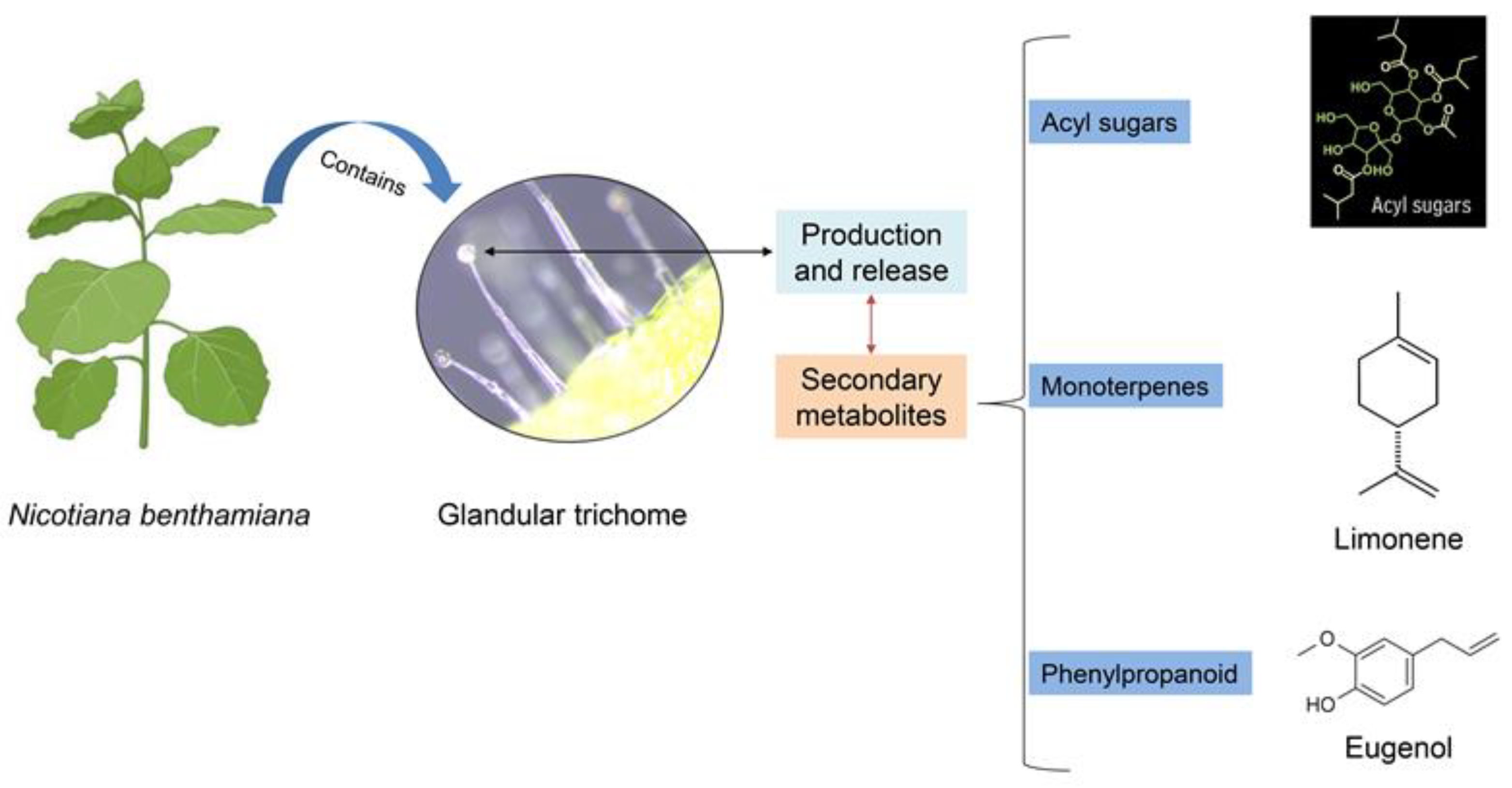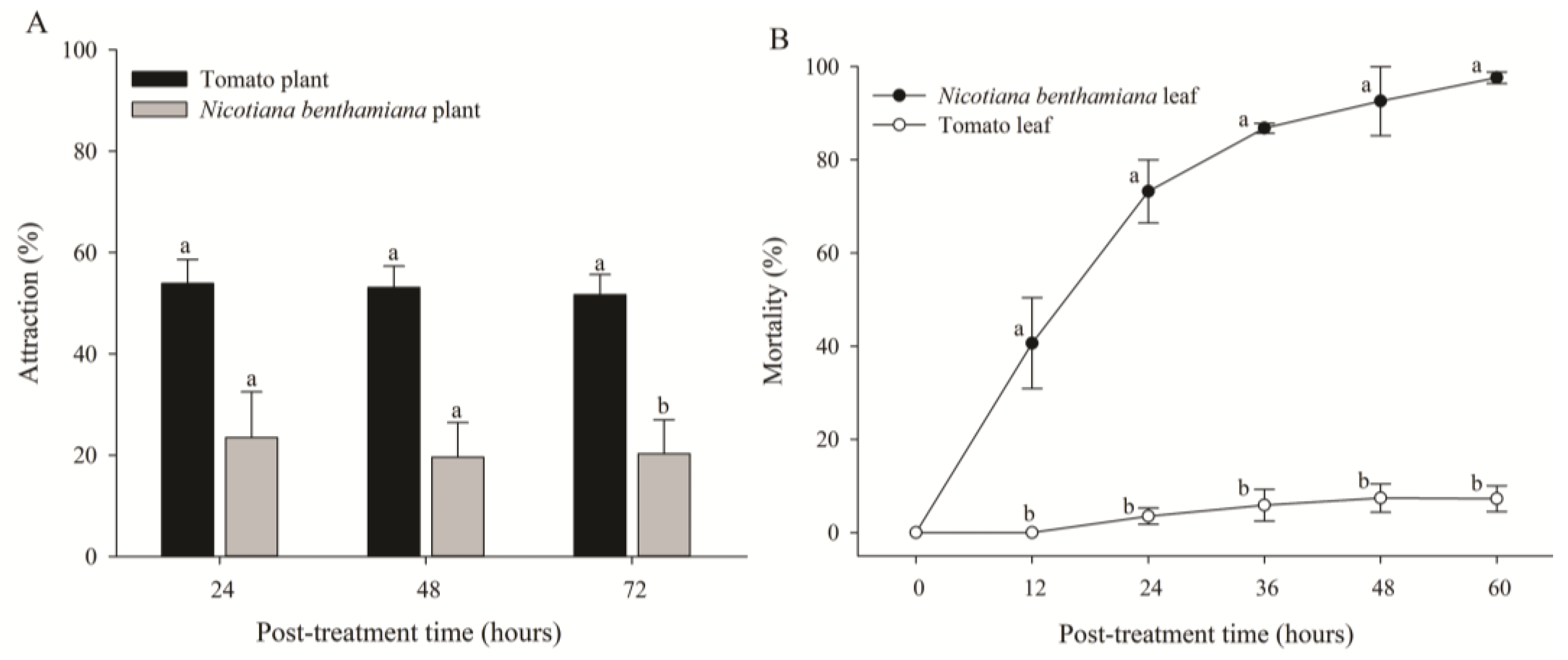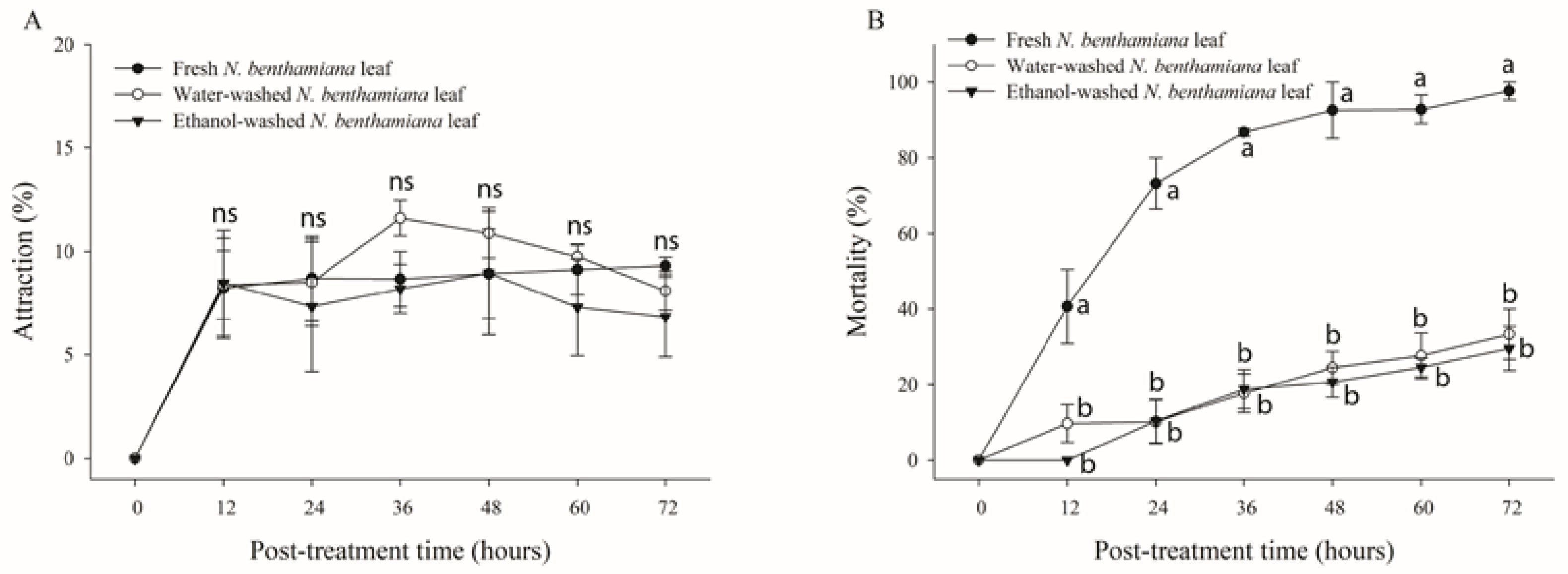Insecticidal Activity of Nicotiana benthamiana Trichome Exudates on the Sweetpotato Whitefly Bemisia tabaci MED (Gennadius)
Abstract
:1. Introduction
2. Materials and Methods
2.1. Insects and Plants
2.2. Preparation of Trichome Exudate Extracts from N. benthamiana Leaves and the Main Components
2.3. Host Preferences of Bemisia tabaci between Tomato and Nicotiana benthamiana Plants
2.4. Oral Toxicity of Trichome Solutions against Bemisia tabaci
2.5. Effects of Trichome Exudate Powder (TEP) on Bemisia tabaci Adults
2.6. Statistical Analysis
3. Results
3.1. Effects of Nicotiana benthamiana on Attraction and Contact Toxicity to Bemisia tabaci Adults
3.2. Effects of Nicotiana benthamiana Trichome-Washed Solutions (TWSs) on Oral Toxicity to Bemisia tabaci Adults
3.3. Effects of Trichome Exudate Powder (TEP) on Bemisia tabaci Adults
4. Discussion
5. Conclusions
Author Contributions
Funding
Institutional Review Board Statement
Informed Consent Statement
Data Availability Statement
Acknowledgments
Conflicts of Interest
References
- Boykin, L.M.; Shatters, R.G.; Rosell, R.C.; McKenzie, C.L.; Bagnall, R.A.; De Barro, P.; Frohlich, D.R. Global relationships of Bemisia tabaci (Hemiptera: Aleyrodidae) revealed using Bayesian analysis of mitochondrial COI DNA sequences. Mol. Phylogenet. Evol. 2007, 44, 1306–1319. [Google Scholar] [CrossRef] [PubMed]
- De Barro, P.J.; Liu, S.S.; Boykin, L.M.; Dinsdale, A.B. Bemisia tabaci: A statement of species status. Annu. Rev. Entomol. 2011, 56, 1–19. [Google Scholar] [CrossRef] [PubMed]
- Kanakala, S.; Ghanim, M. Global genetic diversity and geographical distribution of Bemisia tabaci and its bacterial endosymbionts. PLoS ONE 2019, 14, e0213946. [Google Scholar] [CrossRef]
- De Marchi, B.R.; Gama, A.B.; Smith, H.A. Evidence of the association between the Q2 mitochondrial group of Bemisia tabaci MED species (Hemiptera: Aleyrodidae) and low competitive displacement capability. PLoS ONE 2023, 18, e0280002. [Google Scholar] [CrossRef]
- Oliveira, M.R.V.; Henneberry, T.J.; Anderson, P. History, current status, and collaborative research projects for Bemisia tabaci. Crop Prot. 2001, 20, 709–723. [Google Scholar] [CrossRef]
- Gelman, D.B.; Blackburn, M.B.; Hu, J.S. Identification of the molting hormone of the sweet potato (Bemisia tabaci) and greenhouse (Trialeurodes vaporariorum) whitefly. J. Insect Physiol. 2005, 51, 47–53. [Google Scholar] [CrossRef] [PubMed]
- Perring, T.M.; Stansly, P.A.; Liu, T.X.; Smith, H.A.; Andreason, S.A. Whiteflies: Biology, Ecology, and Management. In Sustainable Management of Arthropod Pests of Tomato; Academic Press: Cambridge, MA, USA, 2017; pp. 73–110. ISBN 9780128024416. [Google Scholar]
- Jones, D.R. Plant viruses transmitted by thrips. Eur. J. Plant Pathol. 2005, 113, 119–157. [Google Scholar] [CrossRef]
- Polston, J.E.; De Barro, P.; Boykin, L.M. Transmission specificities of plant viruses with the newly identified species of the Bemisia tabaci species complex. Pest Manag. Sci. 2014, 70, 1547–1552. [Google Scholar] [CrossRef]
- Horowitz, A.R.; Kontsedalov, S.; Khasdan, V.; Ishaaya, I. Biotypes B and Q of Bemisia tabaci and their relevance to neonicotinoid and pyriproxyfen resistance. In Proceedings of the Archives of Insect Biochemistry and Physiology; John Wiley & Sons, Ltd.: Hoboken, NJ, USA, 2005; Volume 58, pp. 216–225. [Google Scholar]
- Watanabe, L.F.M.; Bello, V.H.; De Marchi, B.R.; da Silva, F.B.; Fusco, L.M.; Sartori, M.M.P.; Pavan, M.A.; Krause-Sakate, R. Performance and competitive displacement of Bemisia tabaci MEAM1 and MED cryptic species on different host plants. Crop Prot. 2019, 124, 104860. [Google Scholar] [CrossRef]
- Ally, H.M.; El Hamss, H.; Simiand, C.; Maruthi, M.N.; Colvin, J.; Delatte, H. Genetic diversity, distribution, and structure of Bemisia tabaci whitefly species in potential invasion and hybridization regions of East Africa. PLoS ONE 2023, 18, e0285967. [Google Scholar] [CrossRef]
- Khalid, M.Z.; Ahmed, S.; Al-Ashkar, I.; Sabagh, A.E.L.; Liu, L.; Zhong, G. Evaluation of resistance development in Bemisia tabaci genn. (homoptera: Aleyrodidae) in cotton against different insecticides. Insects 2021, 12, 996. [Google Scholar] [CrossRef] [PubMed]
- Basij, M.; Talebi, K.; Ghadamyari, M.; Hosseininaveh, V.; Salami, S.A. Status of Resistance of Bemisia tabaci (Hemiptera: Aleyrodidae) to Neonicotinoids in Iran and Detoxification by Cytochrome P450-Dependent Monooxygenases. Neotrop. Entomol. 2017, 46, 115–124. [Google Scholar] [CrossRef] [PubMed]
- Johnson, Z.; Kaur, I.; Castillo, F.; Kariyat, R.; Bandyopadhyay, D. Aloe barbadensis rinds employ physical and chemical defense mechanisms against insect herbivores with varying success. Ind. Crops Prod. 2023, 194, 116347. [Google Scholar] [CrossRef]
- Wang, X.; Shen, C.; Meng, P.; Tan, G.; Lv, L. Analysis and review of trichomes in plants. BMC Plant Biol. 2021, 21, 70. [Google Scholar] [CrossRef] [PubMed]
- Wagner, G.J.; Wang, E.; Shepherd, R.W. New approaches for studying and exploiting an old protuberance, the plant trichome. Ann. Bot. 2004, 93, 3–11. [Google Scholar] [CrossRef] [PubMed]
- Slocombe, S.P.; Schauvinhold, I.; McQuinn, R.P.; Besser, K.; Welsby, N.A.; Harper, A.; Aziz, N.; Li, Y.; Larson, T.R.; Giovannoni, J.; et al. Transcriptomic and reverse genetic analyses of branched-chain fatty acid and acyl sugar production in Solanum pennellii and Nicotiana benthamiana. Plant Physiol. 2008, 148, 1830–1846. [Google Scholar] [CrossRef] [PubMed]
- Muigai, S.G.; Schuster, D.J.; Snyder, J.C.; Scott, J.W.; Bassett, M.J.; McAuslane, H.J. Mechanisms of resistance in Lycopersicon germplasm to the whitefly Bemisia argentifolii. Phytoparasitica 2002, 30, 347–360. [Google Scholar] [CrossRef]
- Kroumova, A.B.; Wagner, G.J. Different elongation pathways in the biosynthesis of acyl groups of trichome exudate sugar esters from various solanaceous plants. Planta 2003, 216, 1013–1021. [Google Scholar] [CrossRef]
- Uzelac, B.; Stojičić, D.; Budimir, S. Glandular trichomes on the leaves of Nicotiana tabacum: Morphology, developmental ultrastructure, and secondary metabolites. In Reference Series in Phytochemistry; Springer Science and Business Media B.V.: Cham, Switzerland, 2019; pp. 1–37. [Google Scholar]
- Simmons, A.T.; Gurr, G.M.; McGrath, D.; Martin, P.M.; Nicol, H.I. Entrapment of Helicoverpa armigera (Hübner) (Lepidoptera: Noctuidae) on glandular trichomes of Lycopersicon species. Aust. J. Entomol. 2004, 43, 196–200. [Google Scholar] [CrossRef]
- Goffreda, J.C.; Mutschler, M.A.; Tingey, W.M. Feeding behavior of potato aphid affected by glandular trichomes of wild tomato. Entomol. Exp. Appl. 1988, 48, 101–107. [Google Scholar] [CrossRef]
- Puterka, G.J.; Farone, W.; Palmer, T.; Barrington, A. Structure-Function Relationships Affecting the Insecticidal and Miticidal Activity of Sugar Esters. J. Econ. Entomol. 2003, 96, 636–644. [Google Scholar] [CrossRef] [PubMed]
- Wang, R.; Gao, B.; Zhang, Q.; Zhang, Z.; Li, Y.; Yang, Q.; Zhang, M.; Li, W.; Luo, C. Acylsugar protection of Nicotiana benthamiana confers mortality and transgenerational fitness costs in Spodoptera litura. Front. Plant Sci. 2022, 13, 993279. [Google Scholar] [CrossRef] [PubMed]
- SAS Institute Inc. Base SAS 9.4 Procedures Guide: High-Performance Procedures, 6th ed.; SAS Institute Inc.: Cary, NC, USA, 2016. [Google Scholar]
- Simmons, A.T.; Gurr, G.M. Trichomes of Lycopersicon species and their hybrids: Effects on pests and natural enemies. Agric. For. Entomol. 2005, 7, 265–276. [Google Scholar] [CrossRef]
- Goffreda, J.C.; Mutschler, M.A.; Avé, D.A.; Tingey, W.M.; Steffens, J.C. Aphid deterrence by glucose esters in glandular trichome exudate of the wild tomato, Lycopersicon pennellii. J. Chem. Ecol. 1989, 15, 2135–2147. [Google Scholar] [CrossRef] [PubMed]
- Wagner, G.J. Secreting glandular trichomes: More than just hairs. Plant Physiol. 1991, 96, 675–679. [Google Scholar] [CrossRef] [PubMed]
- Simmons, A.T.; Gurr, G.M.; McGrath, D.; Nicol, H.I.; Martin, P.M. Trichomes of Lycopersicon spp. and their effect on Myzus persicae (Sulzer) (Hemiptera: Aphididae). Aust. J. Entomol. 2003, 42, 373–378. [Google Scholar] [CrossRef]
- Vilela De Resende, J.T.; Maluf, W.R.; Faria, M.V.; Pfann, A.Z.; Rodrigues Do Nascimento, I. Acylsugars in tomato leaflets confer resistance to the South American tomato pinworm, Tuta absoluta Meyr. Sci. Agric. 2006, 63, 20–25. [Google Scholar] [CrossRef]
- Arrendale, R.F.; Severson, R.F.; Sisson, V.A.; Costello, C.E.; Leary, J.A.; Himmelsbach, D.S.; van Halbeek, H.; Sisson, V.A.; Costello, C.E.; Leary, J.A.; et al. Characterization of the Sucrose Ester Fraction from Nicotiana glutinosa. J. Agric. Food Chem. 1990, 38, 75–85. [Google Scholar] [CrossRef]
- Morimoto, M. Chemical defense against insects in Heterotheca subaxillaris and three Orobanchaceae species using exudates from trichomes. Pest Manag. Sci. 2019, 75, 2474–2481. [Google Scholar] [CrossRef]
- Johnston, N.; Paris, T.; Paret, M.L.; Freeman, J.; Martini, X. Repelling whitefly (Bemisia tabaci) using limonene-scented kaolin: A novel pest management strategy. Crop Prot. 2022, 154, 105905. [Google Scholar] [CrossRef]
- He, Y.; Zhang, J.; Shen, L.; Wang, L.; Qian, C.; Lyu, H.; Yi, C.; Cai, J.; Chen, X.; Wen, X.; et al. Eugenol derivatives: Strong and long-lasting repellents against both undisturbed and disturbed red imported fire ants. J. Pest Sci. (2004) 2023, 96, 327–344. [Google Scholar] [CrossRef]
- Mostafiz, M.M.; Jhan, P.K.; Shim, J.-K.; Lee, K.-Y. Methyl benzoate exhibits insecticidal and repellent activities against Bemisia tabaci (Gennadius) (Hemiptera: Aleyrodidae). PLoS ONE 2018, 13, e0208552. [Google Scholar] [CrossRef] [PubMed]
- Mostafiz, M.M.; Shim, J.-K.; Hwang, H.-S.; Bunch, H.; Lee, K.-Y. Acaricidal effects of methyl benzoate against Tetranychus urticae Koch (Acari: Tetranychidae) on common crop plants. Pest Manag. Sci. 2020, 76, 2347–2354. [Google Scholar] [CrossRef] [PubMed]
- Mostafiz, M.M.; Hassan, E.; Shim, J.K.; Lee, K.Y. Insecticidal efficacy of three benzoate derivatives against Aphis gossypii and its predator Chrysoperla carnea. Ecotoxicol. Environ. Saf. 2019, 184, 109653. [Google Scholar] [CrossRef]
- Mostafiz, M.M.; Hassan, E.; Lee, K.Y. Methyl Benzoate as a Promising, Environmentally Safe Insecticide: Current Status and Future Perspectives. Agriculture 2022, 12, 378. [Google Scholar] [CrossRef]





| Ethanol-Washed Concentration (%) | LT50 (h) | 95% CI † (Lower–Upper) | Slope (SEM) | X2 (df) |
|---|---|---|---|---|
| 0.0 | 158.7 a * | (102.4–452.0) | 1.9 (0.42) | 1.2 (3) |
| 0.1 | 52.2 b | (47.1–59.7) | 3.1 (0.35) | 3.3 (3) |
| 1.0 | 29.4 c | (22.6–35.8) | 5.7 (0.84) | 11.9 (3) |
| 20 | 22.2 cd | (13.8–30.1) | 5.3 (1.02) | 20.8 (3) |
| Toxicity Extract | Concentrations (%) | Mortality (M ± SE) at Different Post-Treatment Times (h) | |||
|---|---|---|---|---|---|
| 12 | 24 | 36 | 48 | ||
| Control | 0.0 | 3.3 ± 1.7 | 8.3 ± 1.7 | 13.3 ± 3.3 | 18.3 ± 1.7 |
| Water-washed TEP | 0.1 | 8.0 ± 6.1 a | 32.0 ± 6.1 a | 46.7 ± 6.7 a | 46.7 ± 6.7 a |
| 1.0 | 12.0 ± 2.3 a | 56.0 ± 2.3 b | 61.3 ± 1.3 b | 64.0 ± 2.3 b | |
| 10 | 10.7 ± 2.7 a | 60.0 ± 2.3 b | 73.3 ± 1.3 c | 81.3 ± 4.8 c | |
| Ethanol-washed TEP | 0.1 | 12.0 ± 4.6 a | 58.7 ± 4.8 a | 80.0 ± 2.3 a | 92.0 ± 2.3 |
| 1.0 | 20.0 ± 2.9 a | 80.0 ± 2.9 b | 100.0 ± 0.0 b | - | |
| 10 | 21.7 ± 3.3 a | 85.0 ± 2.9 b | 100.0 ± 0.0 b | - | |
| Imidacloprid | 0.1 | 13.3 ± 8.8 a | 63.3 ± 8.8 a | 100.0 ± 0.0 a | - |
| 1.0 | 20.0 ± 10 a | 83.3 ± 3.3 b | 100.0 ± 0.0 a | - | |
Disclaimer/Publisher’s Note: The statements, opinions and data contained in all publications are solely those of the individual author(s) and contributor(s) and not of MDPI and/or the editor(s). MDPI and/or the editor(s) disclaim responsibility for any injury to people or property resulting from any ideas, methods, instructions or products referred to in the content. |
© 2023 by the authors. Licensee MDPI, Basel, Switzerland. This article is an open access article distributed under the terms and conditions of the Creative Commons Attribution (CC BY) license (https://creativecommons.org/licenses/by/4.0/).
Share and Cite
Sharma, S.R.; Mostafiz, M.M.; Lee, K.-Y. Insecticidal Activity of Nicotiana benthamiana Trichome Exudates on the Sweetpotato Whitefly Bemisia tabaci MED (Gennadius). Agrochemicals 2023, 2, 598-607. https://doi.org/10.3390/agrochemicals2040034
Sharma SR, Mostafiz MM, Lee K-Y. Insecticidal Activity of Nicotiana benthamiana Trichome Exudates on the Sweetpotato Whitefly Bemisia tabaci MED (Gennadius). Agrochemicals. 2023; 2(4):598-607. https://doi.org/10.3390/agrochemicals2040034
Chicago/Turabian StyleSharma, Sushant Raj, Md Munir Mostafiz, and Kyeong-Yeoll Lee. 2023. "Insecticidal Activity of Nicotiana benthamiana Trichome Exudates on the Sweetpotato Whitefly Bemisia tabaci MED (Gennadius)" Agrochemicals 2, no. 4: 598-607. https://doi.org/10.3390/agrochemicals2040034
APA StyleSharma, S. R., Mostafiz, M. M., & Lee, K.-Y. (2023). Insecticidal Activity of Nicotiana benthamiana Trichome Exudates on the Sweetpotato Whitefly Bemisia tabaci MED (Gennadius). Agrochemicals, 2(4), 598-607. https://doi.org/10.3390/agrochemicals2040034









